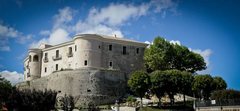Carlo Gesualdo @RISM
Martina Falletta
Wednesday, September 25, 2013

Wagner and Verdi are not the only big musical names marking anniversaries this year. Carlo Gesualdo died on 8 September 1613 – 400 years ago. The Principe di Venosa was noted in his time for his bold chromaticisms and was a champion of polyphony in an era when others like Monteverdi tended to allow one voice to dominate.
Gesualdo also went down in history as a jealous spouse, murderer, and eccentric nobleman. He was born in 1566, likely in or around Naples. He came from a wealthy family, which allowed him to receive a good musical education (lute, voice, counterpoint, and composition) and was brought up wholly in line with Baldassare Castiglione’s The Book of the Courtier. When his older brother died, he moved up in succession and in 1586 he became the Prince of Venosa. In the same year, he married his cousin Maria d‘Avalos (ca. 1560-1590) for political reasons. To this day, it is still uncertain whether Gesualdo himself murdered his wife and her lover or merely ordered it to be done. Initially he fled, probably in fear of revenge from the d’Avalos family. In 1594, he married Leonora d‘Este from Ferrara, where he remained for two years and where many of his madrigals were probably written.
The pieces in the Sacrarum cantionum (Napels, 1603; RISM A/I: G 1719) have been only incompletely preserved; the bass and the sixth voice are missing. The British conductor, composer, and musicologist James Wood painstakingly attempted to reconstruct the two lost parts. The results can be heard on a recently-released CD, which was just awarded the prestigious ECHO Music Prize for Choral Recording of the Year (Miserere (1611); Sacrae Cantiones, Liber secundus (1603), reconstructed by James Wood. Vocalconsort Berlin, James Wood, harmonia mundi HMC 902123).
Gesualdo’s madrigals also attracted special attention from the Madrigal Society in London, as can be seen from extant sources. The RISM online catalog offers nearly 170 records if you do a keyword search for: Gesualdo Madrigal Society London. Rounding this out are an additional ca. 40 manuscripts of Gesualdo’s works, in addition to numerous prints in the series A/I (G/GG 1718 – 1744) and B/I (1585|2, 1609|16, 1610|14 (2), 1615|14 (3), 1616|15, 1618|11 (2)).
Share Tweet EmailCategory: Musical anniversaries

